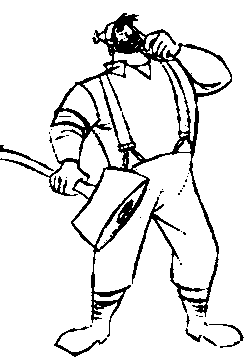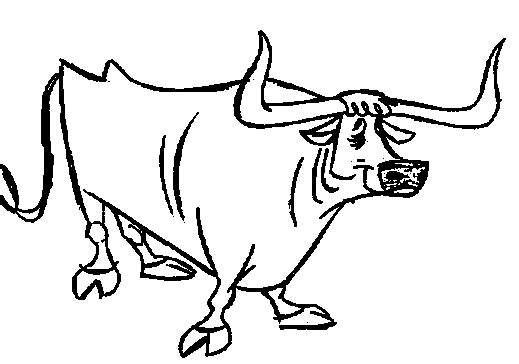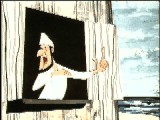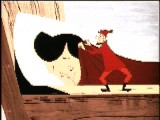Articles
From Traditional to Digital Animation
 After telling the origin of the character, the feature focused on Bunyan's greatest challenge. It was competition with a salesman armed with a tree cutting machine. It was the classic conflict, man against machine.
After telling the origin of the character, the feature focused on Bunyan's greatest challenge. It was competition with a salesman armed with a tree cutting machine. It was the classic conflict, man against machine.
This conflict is quite powerful in our culture. One of the most popular conceptions from the media, science fiction and modern myth is the belief that eventually, machines will replace humans.
The creators of Paul Bunyan constantly reused two animation sequences. One showed Bunyan cutting trees in the forest with a karate move.
The other sequence was Bunyan's wrestling match with Babe. The titans' wreckage carved the Grand Canyons. The second time the producers reused the sequence, it depicted the whereabouts of the friends at the end of the cartoon.
 The wrestling sequence was different from the tree cutting one. Artists painted the background with another color palette. The characters were no longer in the Grand Canyons. They were in Alaska.
The wrestling sequence was different from the tree cutting one. Artists painted the background with another color palette. The characters were no longer in the Grand Canyons. They were in Alaska.
The reused animations in Paul Bunyan shows care and ingenuity. Because of costs, time, storytelling and other commitments, the producers reused parts of the animation instead of drawing new sequences. Considering the technical developments of the time, this was the way to go.
Today's productions have the same obligations. Like the Paul Bunyan cartoon, the preparation counts more than the actual tools. Digital tools often increase productivity and alleviate repetitive, but needed tasks. They do not replace human thought. They serve it.
Coloring and compositing of animation elements have gained the most, from the digitalization of animation. Other jobs, such as scanning and non linear editing, were added to fit the transfer and take advantage of the digital opportunities.
 In 1958, a team of artists inked and painted each cel in Paul Bunyan manually. They learned this craft over a long time. If Paul Bunyan were produced today, Disney could train most colorists in a few days. Their output would surpass anything the old masters did at their peak.
In 1958, a team of artists inked and painted each cel in Paul Bunyan manually. They learned this craft over a long time. If Paul Bunyan were produced today, Disney could train most colorists in a few days. Their output would surpass anything the old masters did at their peak.
The number of colorists would diminish, reducing the management of documents and crews. The Studio would no longer shelve cels and leave them to dry in in the back. Errors could easily be fixed. Model changes in the midst of production, though undesired, would be viable. For example, the sparring sequence between Bunyan and Babe in the Grand Canyons could be copied and transformed as an Alaskan set in minutes.
The most pressing concern remains quality. As stated before, errors can be fixed easily in digital coloring. This increases quality automatically. Digital ink and paint can mimic most traditional animation coloring styles. It has even introduced new ones, such as textured paints and soft edges on shadow mattes. However, a poor choice of palettes is as bad in digital colored animations as in hand painted ones. The skills and judgment of the designers affect quality issues, not computers.
 The production of animation is procedural and often team-based. Computing technology helps animation creators in many places during a production. Technology offers studios more experimentation at lesser costs. The important variable is not the machine, as in Disney's Paul Bunyan, it is the artist.
The production of animation is procedural and often team-based. Computing technology helps animation creators in many places during a production. Technology offers studios more experimentation at lesser costs. The important variable is not the machine, as in Disney's Paul Bunyan, it is the artist.
Coolstreak Cartoons Inc.
Copyright ® 2002. Use of material in this document®including reproduction, modification, distribution, electronic transmission or republication®without prior written permission is strictly prohibited.
|



